Only the Enemy in Front: Late-War British Reconnaissance in FOW
By Richard Steer
Bulge: British is the final book covering Late-War British forces for Flames of War 4th Edition. Combined with D-Day: British, these books are Flames of War’s representation of the British, Canadian, and Polish forces in Northwest Europe from D-Day through until VE Day.
Supporting each book is a deck of Command Cards. These cards add additional formations, units, and upgraded weapons, that are not included in the core books. Amongst the cards for the British books there are a number of options for different reconnaissance units. This article looks at the historical units, and how they have been represented in the lists.

There were four British and two Canadian armoured car regiments in Northwest Europe. For the invasion of France these were all held at the corps level and attached out to units as needed, but eventually an armoured car regiment was assigned to each of the three British armoured divisions.
- 2nd Household Cavalry: 8 Corps then Guards Armoured Division.
- 1st Royal Dragoons: 12 Corps.
- 11th Hussars: 30 Corps then 7th Armoured Division.
- Inns of Court: 1 Corps then 11th Armoured Division.
- Royal Canadian Dragoons: 1 Canadian Corps (arrived from Italy in March 1945)
- 12th Manitoba Dragoons: 2 Canadian Corps
Armoured Car Squadron (Command Card from Bulge: British)
The Armoured Car Squadron command card reflects the standard structure of a British Armoured Car Squadron and is suitable for any of the British armoured car regiments except Inns of Court.

The historical Squadron HQ was always equipped with Staghounds, but Daimlers have presumably been allowed to avoid forcing players to purchase special order models. The standard organization for an Armoured Car Troop was two Daimler armoured cars and two Dingo scout cars.

The armoured car squadrons also contained a Heavy Troop of 75mm-armed cars. This is not listed on the squadron card, but can be added through the separate Matador Armoured Cars card, creating a unit of two or three AEC Mk III Matadors.
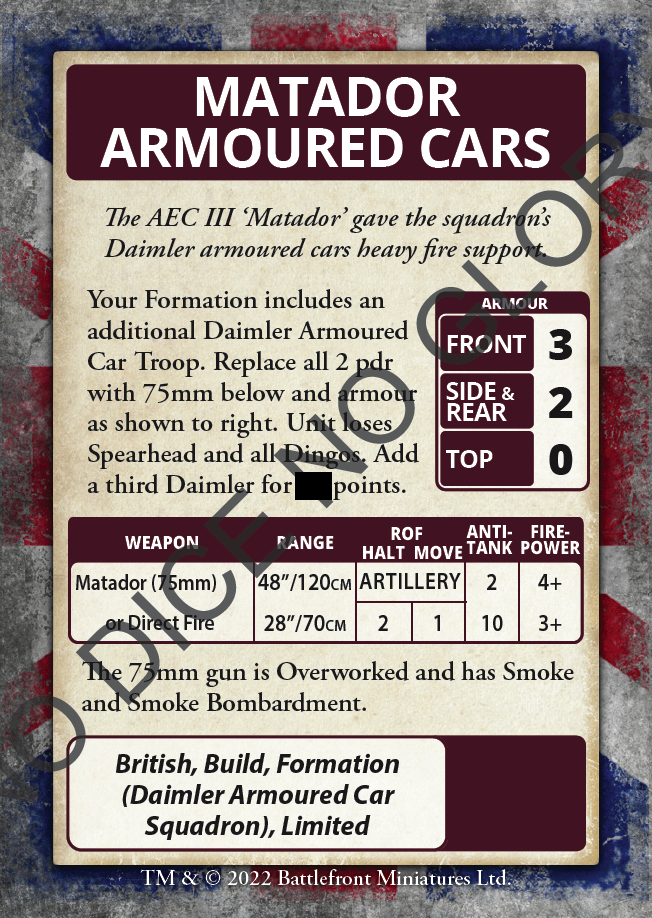
2nd Household Cavalry was the only regiment of those represented by the standard Armoured Car Squadron card to use Matadors. These were allocated in a Heavy Troop of two per squadron. The Royals and 11th Hussars had M3 75mm GMC half-tracks in their Heavy Troops instead of Matadors, but these are not available as an option.
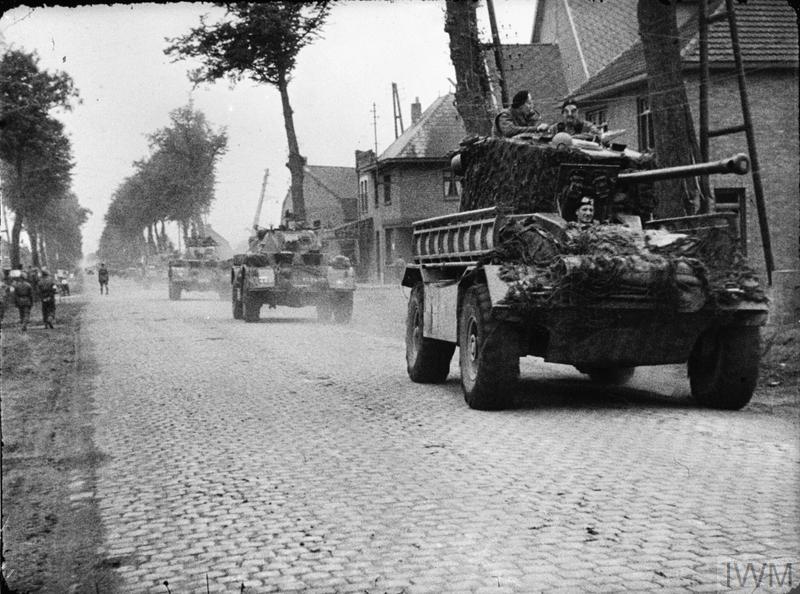
Inns of Court (Command Card from Bulge: British)
Inns of Court was the armoured car regiment of 11th Armoured Division. Their squadrons adopted a unique structure, represented by a command card in Bulge: British.

The organization listed on the card reflects the structure of the regiment’s squadrons from July 1944 until February 1945, at which point they reverted to the normal Armoured Car Squadron structure. Once again, the historical Squadron HQ was equipped with Staghounds. The list isn’t quite correct as the six Dingo Patrols each had pairs of cars, rather than the three cars in the Dingo Recce Patrol unit. The Matadors were organized in troops of three, centralized in their own squadron, but were removed from the regiment by December 1944.

The Sawn-Off Daimler was a field modification of the Daimler armored car by Inns of Court. It involved removing the turret and front mud-guards, turning it into a scout car to make up for having insufficient Dingos. The Sawn-Off Daimler command card replaces one of the Daimler armored cars with a SOD, but when the SODs were first introduced in July 1944 it was used in place of the Dingo. To reflect that arrangement, I would suggest using the standard three-vehicle Daimler Armoured Car Troop, with a SOD in place of the Dingo, rather than this command card. This could be with or without the Littlejohn Adapter upgrade for one of the Daimlers.

Manitoba Dragoons (Command Card from Bulge: British)
The Canadian armoured car regiments were equipped with the larger Staghound armored car instead of Daimlers. This is represented by the 12th Manitoba Dragoons card. It equally applies to the Royal Canadian Dragoons, who transferred from Italy to Northwest Europe in March 1945.

12th Manitoba Dragoons received one Matador on 3 September 1944 and were expecting a total of eight, but it doesn’t appear that they received the other seven. The regiment did receive three Staghound IIIs in April 1945. These were Staghounds fitted with the turret of a Crusader III, which had had the 6pdr rebored as a 75mm. There is no card for this vehicle, but its stats would be equivalent to a Matador so these could potentially be proxied.
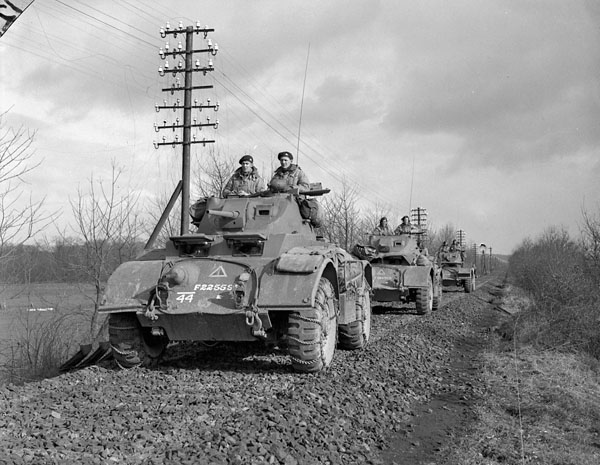
Recce Squadrons (Command Cards from both D-Day: British and Bulge: British)
Each British and Canadian infantry division contained a Reconnaissance Regiment: a self-contained unit of armored cars, carriers, motorized infantry, mortars, and anti-tank guns. These units are represented in Flames of War by the Recce Squadron command card.
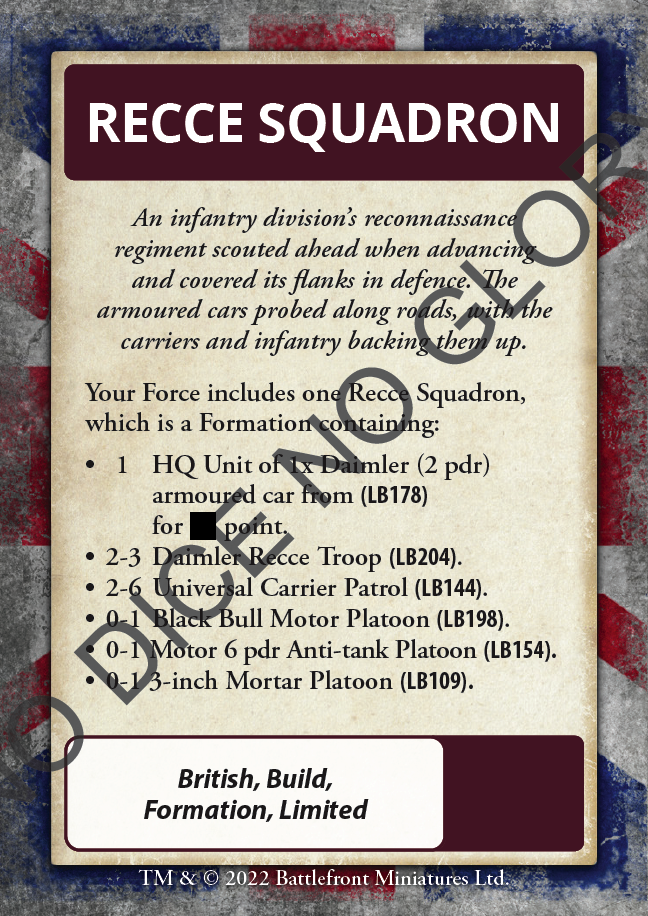
There was a large amount of variation in the way that the Recce Regiments were equipped. Most had Humber armored cars and Humber light recce cars (LRCs) when they landed in France. 2nd Derbyshire Yeomanry, the recce regiment of 51st (Highland) Division, had Daimler armored cars and LRCs. 52nd Recce Regiment only had Dingos for most of the campaign.
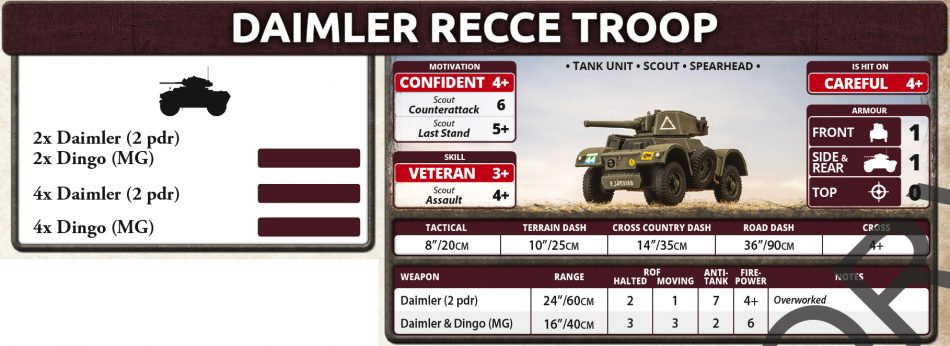
The British lists in FOW do not have Humbers and LRCs available as options. Instead, the Recce Troop offers three different combinations of Daimler and Dingo. The Humber armored cars were the 37mm-armed Mk IV, so would have equivalent stats to the Daimler. Similarly, the LRC would have stats that are similar to the Dingo. Proxying should be a valid option if you have the models and want to play with the earlier equipment.
The first option matches the structure of a normal Recce Section, which contained two armored cars and two LRCs. Dingos started replacing the LRCs in 1945, and a number of regiments were re-equipped with Daimler armored cars as the campaign progressed, so the Daimler/Dingo combination is historically valid for the last few months of the war.
However, the unit is representing the wheeled component of the Recce Troop, and as such is not complete as each troop also had an HQ of another armored car. This is probably a case of the unit structure in the game being determined by the contents of the armored car platoon boxed set.
The unit of four Dingos is from 52nd Recce Regiment. As part of 52nd (Lowland) Division, they were trained and organized as a mountain division, and because of this, they had only scout cars until they started receiving Daimlers in February 1945.
An example of a unit with four Daimlers could be 43rd Recce Regiment. When they started receiving Daimlers in March 1945 they ran troops containing two Daimlers, two Humbers, and an LRC. The Humbers were to be replaced with more Daimlers as they were lost.

Another option that is missing, possibly for the best from a game balance perspective, is 7th Canadian Recce Regiment. From September 1944 they operated a number of Wasp flame-throwers in their Carrier Patrols.

Reflections
The historical completeness of the British reconnaissance lists in Flames of War has definitely taken a step backward in V4. I expect this is largely due to the practicalities of Battlefront rationalizing the retail product line through the use of platoon boxes. The British operated a crazy array of reconnaissance equipment, and while it would have been nice for them all to be in the books, that variety doesn’t fit nicely with the miniatures being sold in a limited range of platoon boxes.
If there can only be one box of Late-War British armored cars, then it makes sense for that to be the one containing two Daimler/Dingo sprues as that covers a lot of bases. Battlefront has taken steps towards addressing the gaps in the retail range through the command cards and having the Staghound, Matador, and Sawn-Off Daimler available as direct order items to support them. That exceeds the level of special order support for any of the previous V4 releases but is still short of what would be required to cover all of the historical variations.
The details of the lists are interesting, but the main thing that reconnaissance forces in general are missing in Flames of War is a role. Games with an open list format, even using the Battle Plans mission selector, do not lend themselves to the historical reconnaissance roles of scouting, screening, and pursuit. This has led to their primary use being to provide a cheap framework around which to stack support units. With a little preparation, it is possible to play games giving recce lists the role that they deserve, but that is a discussion for another time.


Excellent evaluation Richard!
Recce without all of the options.
Missed opportunity BF!
If BF ever return to LW Italy (yes a big IF) I would love to see the Kiwis Div Cav as an option.
Absolutely, the NZ Div Cav Staghounds are very dear to the hearts of a number of people on our local scene, and we’d love to see them back in the game.